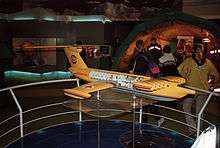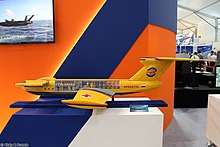Spasatel
Spasatel (Спасатель "The Rescuer" Project 9038) is an ekranoplan project, originally planned by the Soviet Ministry of Defense, which at the time was classified as "Top Secret". Originally the vehicle was intended to serve as the missile carrier of the project Lun, but was then converted into an ambulance, but never completed. Russia has revived the 600-metric-ton-maximum-takeoff-weight (1,300,000 lb; 600,000 kg) ground-effect vehicle to be used for search and rescue operations in the Arctic and Pacific, as well as cargo and troop delivery (up to 550 troops) to remote military bases.[1][2][3][4][5][6][7]

Goals
A military advantage of ground-effect vehicles over ships and submarines was that they did not have draft during operation, and therefore could not be detected by sonar and could not be hit by torpedoes. Advantages over aircraft include operation at low altitude, which makes radar acquisition difficult, and a larger payload. This was particularly interesting during the Cold War as a way to inconspicuously and quickly transport many people or large cargo over long distances.
History
The Spasatel was originally built as a second Lun-class anti-ship missile-carrying ekranoplan. After the Soviet nuclear submarine K-278 Komsomolets sank in 1989, killing 42 people, the Spasatel was repurposed to be deployed in the maritime search and rescue mission, and seating for up to 500 passengers was planned. [8]
After the disintegration of the Soviet Union, the project was cancelled for financial reasons. Military operations at sea were also greatly reduced, so the intended use became less important. The Spasatel is constructed to 98% completion. After the bankruptcy of the Ekranoplan plant, the Spasatel was not scrapped, but, like the rest of the area, was left in a state of unfinished production.
Present

The unfinished Spasatel exists in an old industrial complex in Nizhny Novgorod as of 2020.[9]
Advocates, fans, and former employees of the plant are still working on the completion of the vehicle. It is very difficult to procure components and machinery, as this project is not supported by the Russian government, so the access and production of the Spasatel is very costly and labor intensive. The probability that the Spasatel will ever "fly" is very low. All employees of the Spasatel project work on a volunteer basis.
According to press reports in December 2017, the development of the Spasatel might be resumed, for use mainly in Arctic waters, with production beginning in 2025. According to Russian media, the project is included in the arms budget for the years 2018 to 2025.[10]
See also
- Lun class (military variant, basis of Spasatel)
- TTS-IS
External links
- Presentation of Ekranoplans Spasatel at International Institute for Advanced Aerospace Technologies
- Les Ekranoplanes: Le Spasatel (French)
References
- "Для российских ВС создается транспортно-десантный экраноплан «Спасатель» - Новости общества". mskgazeta.ru. Retrieved 29 December 2018.
- "Part Plane, Part Ship, This 'Ekranoplan' Was a Giant Rescue Vessel". warisboring.com. Retrieved 29 December 2018.
- "Project 9038 - Spasatel". www.globalsecurity.org. Retrieved 29 December 2018.
- "Development of New Ekranoplan Type GEV for Russia`s Navy is underway". Navyrecognition.com. 2017-10-30. Retrieved 2018-12-29.
- "Ekranoplan Reborn: the transport-landing craft for the Russian military will be created by 2025". defence-blog.com. 28 October 2017. Retrieved 29 December 2018.
- "International Institute for Advanced Aerospace Technologies (IIAAT)". iiaat.guap.ru.
- Rogoway, Tyler. "Russia Supposedly Bringing Back Giant Ekranoplans For Arctic Missions". The Drive.
- Ekranoplane «Spasatel» presentation iiaat.guap.ru (English)
- https://www.google.com/maps/place/56%C2%B021'46.0%22N+43%C2%B052'44.0%22E/@56.3627501,43.8780791,173m/data=!3m1!1e3!4m5!3m4!1s0x0:0x0!8m2!3d56.362788!4d43.878875
- "NATO already extremely alarmed: Putin's "Monster of the Caspian Sea" returns". Focus online. 2017-11-18. Retrieved 2017-11-18.